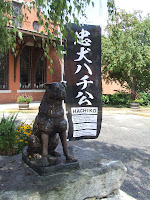by Valerie Paul
Language is no barrier when it comes to Hachiko, the legendary Japanese dog. A visitor stopped to see the new bronze sculpture at the Heritage Corridor last week. Although he spoke little English, he was able to communicate to me how happy he was to see the new “American Hachiko,” as he called it. The dog statue, a replica of one in Japan, was recently unveiled here at the Heritage Corridor’s headquarters where an American version of the Hachiko story was filmed starring Richard Gere. In the movie, based on a true story from the 1920’s in Japan, Hachiko waits each day at the train station for his owner to return for years after his owner died.
After a short attempt at conversation, the visitor signaled that he would get his laptop from his car. We set the laptop up on my desk, where the visitor typed in Japanese into a translating program allowing me to read it in English. I replied in English on my desktop computer, also using a translator, so that the man could read it in Japanese. Through this method, the gentleman was able to tell me that he was in the U.S. for an extended visit. He indicated that he was traveling from New York to Boston and that he scheduled the detour to Woonsocket after he heard about the “American Hachiko” from friends in Japan via e-mail.
We typed back and forth for a while about his trip, the sculpture, and the story of Hachiko. He explained that the story of our dog statue was “big news in Japan.” Using his laptop, he showed me several newspaper stories and a video from a Japanese television station that covered the story of the sculpture’s unveiling at the Heritage Corridor’s office on May 19. When the video finished, he typed, “The Japanese people are very touched by this.”
Before he left, my colleague, Barbara Dixon, gave him the program brochure that was given out at the unveiling ceremony. When I typed the explanation of what the brochure was, he gave a broad smile and then typed “This is very special.”
Since the statue was unveiled, there have been many visitors here taking photos. But the first tourist from Japan, whose name I never got, will always be the one I remember the most. The Japanese people aren’t the only ones who are touched by this.
UPDATE, AUGUST 2, 2012
UPDATE, AUGUST 2, 2012
Today, while sitting at my desk, I looked up to see my Japanese visitor from last June walking in carrying a large banner. Once we got our computers set up again, he indicated that the banner was a gift. The banner says Hachiko in Japanese. Below that in English are listed the Japanese and American locations of the twin Hachiko statues. He typed, “This is a symbol of US-Japanese friendship.”
He then explained that he had brought a box of the flags that could be offered in exchange for a donation. When asked what the donations would be for, he explained that he would like to see a new stone plaque next to the dog statue written in both English and Japanese. (The current plaque is in English only.)
I am rarely speechless, but this gesture left me with no words to explain how astounded and grateful I was for his generosity. I continue to be moved by the Hachiko story and by the value placed on Hachiko’s loyalty by the Japanese public. Now I am equally touched by the generosity of this gentleman who had the flags produced and shipped from Japan so that the "American Hachiko" would have a new plaque for both Japanese and American visitors.
This time, I remembered to get his name. Thank you, Mr. Morita.
HOW TO GET A FLAG
The flags have been sent to the Blackstone Valley Tourism Council who will be working on a donation program. Stay tuned….


